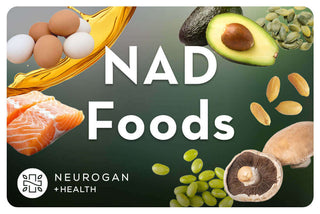Can you eat your way to higher NAD levels?
Yes, and no.
You can't directly find NAD+ (nicotinamide adenine dinucleotide) in foods, but you can eat foods that help your body produce NAD naturally. These foods contain NAD precursors like niacin (vitamin B3), tryptophan, ribose, and polyphenols, which your body can use to build and recycle NAD.
So, what are some of the foods you should add to your next grocery list if you want to support your NAD pools?
Eggs, cheese, pumpkin seeds, mushrooms, avocados, broccoli, cucumbers, cabbage, green tea, dark chocolate, and extra virgin olive oil should make it to the list, and we'll get into why.
How To Get More NAD from Your Foods
You can't directly eat NAD+ in meaningful quantities in foods. Instead, the strategy here is to eat foods that contain NAD precursors or that support your body's ability to produce and recycle NAD.
The key compounds to look for in your diet are:
-
Tryptophan, an amino acid, your body can convert into NAD through the kynurenine pathway.
-
Niacin (vitamin B3) is used by your cells in one of the main NAD synthesis pathways.
-
Nicotinamide riboside (NR) and nicotinamide mononucleotide (NMN) are found in trace amounts in certain foods but are more commonly used in supplements.
-
Polyphenols help activate enzymes (like sirtuins) that depend on NAD to support cell health and repair.

NAD-Supportive Compounds in Foods (per 100g serving)
Here’s a table with estimated amounts of compounds that may support NAD in the body per 100 g serving. The approximate amount you get from each compound is not equivalent to how much of that your body turns into NAD.
Please keep in mind that these values are approximate and can vary by the food variety, preparation, and source. For NR and NMN, levels are extremely low, and data are limited [1, 2, 3, 4, 5, 6, 7, 8].
|
Food |
Key Compound |
Approx. Amount Per 100 g Serving |
|
Beef liver |
Niacin (B3) |
14 mg |
|
Peanuts |
Niacin (B3) |
3 mg |
|
Mushrooms (portobello) |
Niacin (B3) |
4.9 mg |
|
Avocados |
Niacin (B3) |
1.1 mg |
|
Pumpkin Seeds |
Tryptophan |
600 mg |
|
Cheese |
Tryptophan |
320 mg |
|
Salmon |
Tryptophan |
250 mg |
|
Eggs |
Tryptophan |
170 mg |
|
Cow's Milk |
Nicotinamide Riboside (NR) |
<0.25 mg |
|
Edamame |
NMN |
<0.2 mg |
|
Broccoli |
NMN |
<0.1 mg |
|
Dark chocolate (70–85%) |
Polyphenols |
500–800 mg |
|
Olives |
Polyphenols |
100–200 mg |
|
Extra Virgin Olive Oil |
Polyphenols |
100–500 mg |
How To Eat Your Way To Better NAD Levels
While it sounds great in theory, you can’t directly boost your NAD levels just by eating foods that contain it. Even foods rich in NAD precursors like tryptophan, niacin, NMN, or NR don’t deliver high enough concentrations to make a dramatic difference in NAD levels on their own.
But if you feel like eating them, these foods are still great for your overall health. They’re nutrient-dense, support energy metabolism, and contain compounds that help your body naturally recycle NAD.
If your goal is to actively raise NAD levels, the most effective route is through supplementation. Look for:
-
Liposomal NAD+ supplements for direct absorption
-
NADH, NMN, or NR oral supplements, which are NAD precursors, your body can convert efficiently
-
Take your supplements in the morning to sync with your natural energy cycles.
These options are more practical, better absorbed, and easier to maintain consistency with, especially if you’re seeking long-term support for energy, cellular repair, or healthy aging.
Resources:
-
U.S. Department of Agriculture. (n.d.). FoodData Central.
-
National Institutes of Health. (n.d.). Niacin — Fact Sheet for Health Professionals. Office of Dietary Supplements.
-
Trammell, S. A. J., & Brenner, C. (2013). Targeted, LCMS-based metabolomics for quantitative measurement of NAD+ metabolites. Nature Protocols, 8(4), 801–810.
-
Mills, K. F., Yoshida, S., Stein, L. R., Grozio, A., Kubota, S., Sasaki, Y., … Imai, S. I. (2016). Long-term administration of nicotinamide mononucleotide mitigates age-associated physiological decline in mice. Cell Metabolism, 24(6), 795–806.
-
Kim, D. O., & Lee, C. Y. (2002). Extraction and isolation of tryptophan from food samples. Journal of Medicinal Food, 5(3), 143–152.
-
Visioli, F., & Bernardini, E. (2011). Extra virgin olive oil’s polyphenols: Biological activities. Current Pharmaceutical Design, 17(8), 786–804.
-
Williamson, G., & Clifford, M. N. (2010). Colonic metabolites of berry polyphenols: The missing link to biological activity? Journal of the Science of Food and Agriculture, 90(10), 1574–1591.
-
Tokunaga, S., White, I. R., Frost, C., Tanaka, K., & Kono, S. (2002). Green tea consumption and serum lipid profiles: A cross-sectional study in a Japanese population. Journal of Nutritional Biochemistry, 13(12), 769–774.




